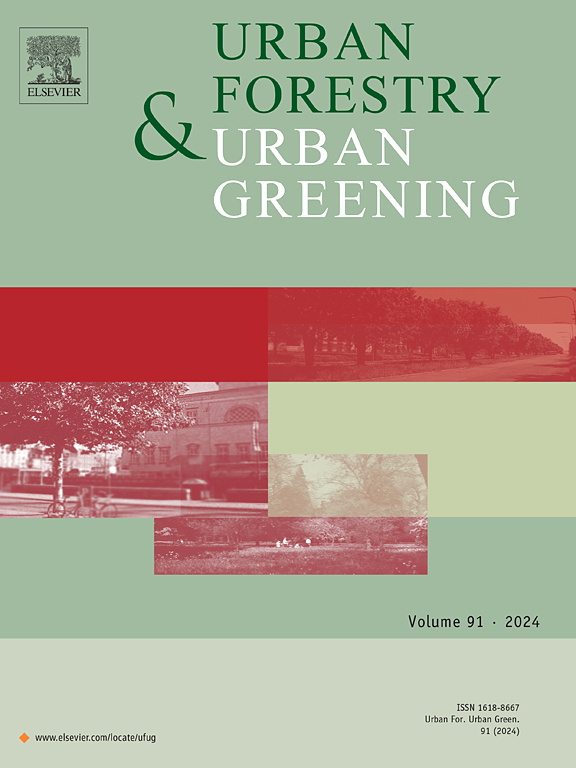Motivations and barriers to integrated management of annual bluegrass in sports fields: US survey findings
IF 6
2区 环境科学与生态学
Q1 ENVIRONMENTAL STUDIES
引用次数: 0
Abstract
Maintaining turfgrass quality is key to deriving ecological, social, and cultural ecosystem services from urban sports fields. Annual bluegrass, the most troublesome weed in U.S. turfgrass systems and a problematic weed in Australasia and Europe, poses serious risks to sustaining these services. Recent U.S. focus groups have documented turfgrass professionals’ concerns about annual bluegrass, particularly the evolution of herbicide resistance and opportunities for improved management. However, comprehensive scientific data have been lacking to test the scale and depth of the concerns and identify significant factors affecting turfgrass manager decisions to adopt remedies. The purpose of this study is to help fill those gaps in scientific knowledge with findings from the first national survey of U.S. sports and recreation turfgrass professionals. Integrated weed management (IWM), a holistic weed management approach that blends chemical and non-chemical practices, is key to slowing the evolution of herbicide resistance, but it meets stiff challenges in practical application. A multivariate regression model tested for factors hypothesized to affect the count of diverse practices used by U.S. sports turfgrass managers. Significant positive influences on practice adoption include the number of employees in a sports field operation, degree of concern about herbicide resistance, Extension educational program attendance, and length of tenure in the sports sector. Insufficient time, a perceived lack of non-chemical options, and a higher education level decrease the total count of practices. The findings support three actions to advance IWM for sports turfgrass: (1) credible and consistent information programs on herbicide resistance risks; (2) development of more non-chemical practices and new herbicide MOAs, and (3) public/private transdisciplinary collaborations to integrate the experiential knowledge of turfgrass professionals with frontier science.
体育领域年度蓝草综合管理的动机和障碍:美国调查结果
保持草坪质量是从城市运动场获得生态、社会和文化生态系统服务的关键。一年生蓝草是美国草坪草系统中最麻烦的杂草,也是澳大拉西亚和欧洲的问题杂草,对维持这些服务构成严重风险。最近的美国焦点小组记录了草坪草专业人士对年度蓝草的担忧,特别是对除草剂抗性的演变和改进管理的机会。然而,缺乏全面的科学数据来检验这些问题的规模和深度,并确定影响草坪管理者采取补救措施决策的重要因素。这项研究的目的是通过对美国体育和娱乐草坪专业人士的首次全国调查来帮助填补这些科学知识的空白。杂草综合管理(IWM)是一种化学与非化学相结合的杂草综合管理方法,是减缓除草剂抗性演变的关键,但在实际应用中面临严峻挑战。一个多元回归模型测试了假设影响美国体育草坪管理者使用的不同实践计数的因素。对实践采用的显著积极影响包括体育领域操作的员工数量,对除草剂抗性的关注程度,扩展教育计划的出席率和体育部门的任期长度。时间不足,缺乏非化学疗法的选择,以及较高的教育水平会减少练习的总数。研究结果支持三项行动来推进运动草坪的人工草坪管理:(1)可靠和一致的除草剂抗性风险信息规划;(2)发展更多的非化学实践和新的除草剂moa;(3)公共/私人跨学科合作,将草坪草专业人员的经验知识与前沿科学相结合。
本文章由计算机程序翻译,如有差异,请以英文原文为准。
求助全文
约1分钟内获得全文
求助全文
来源期刊

Urban Forestry & Urban Greening
FORESTRY-
CiteScore
11.70
自引率
12.50%
发文量
289
审稿时长
70 days
期刊介绍:
Urban Forestry and Urban Greening is a refereed, international journal aimed at presenting high-quality research with urban and peri-urban woody and non-woody vegetation and its use, planning, design, establishment and management as its main topics. Urban Forestry and Urban Greening concentrates on all tree-dominated (as joint together in the urban forest) as well as other green resources in and around urban areas, such as woodlands, public and private urban parks and gardens, urban nature areas, street tree and square plantations, botanical gardens and cemeteries.
The journal welcomes basic and applied research papers, as well as review papers and short communications. Contributions should focus on one or more of the following aspects:
-Form and functions of urban forests and other vegetation, including aspects of urban ecology.
-Policy-making, planning and design related to urban forests and other vegetation.
-Selection and establishment of tree resources and other vegetation for urban environments.
-Management of urban forests and other vegetation.
Original contributions of a high academic standard are invited from a wide range of disciplines and fields, including forestry, biology, horticulture, arboriculture, landscape ecology, pathology, soil science, hydrology, landscape architecture, landscape planning, urban planning and design, economics, sociology, environmental psychology, public health, and education.
 求助内容:
求助内容: 应助结果提醒方式:
应助结果提醒方式:


